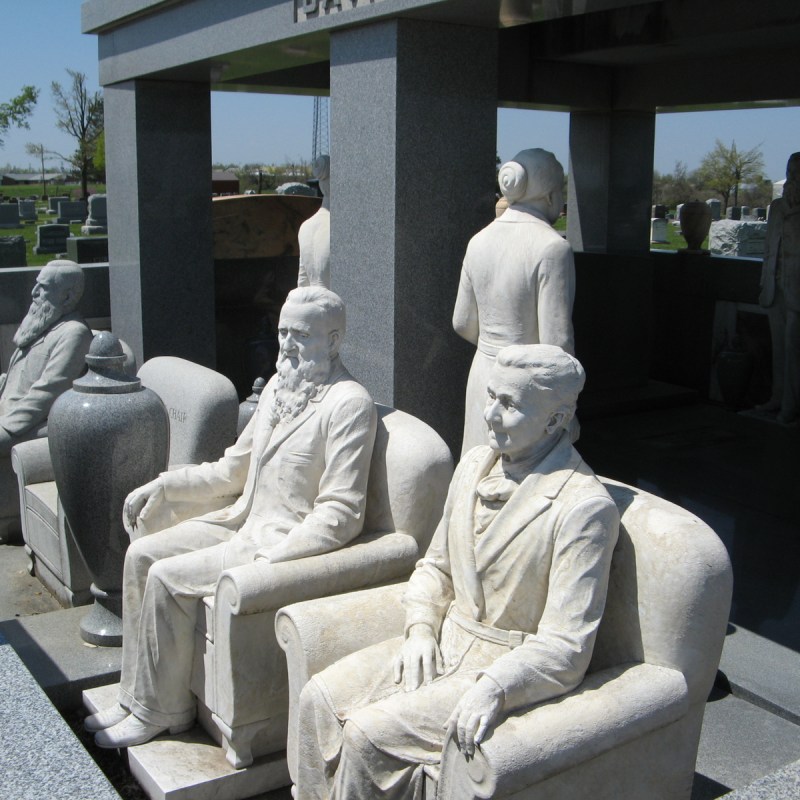
When TravelAwaits writer Amy Piper and I were recently in Hiawatha, Kansas, we were looking for the John and Sarah Davis Memorial, the most famous attraction in Hiawatha. She asked me to drive slower so she could read the headstones. We couldn’t miss the Davis Memorial, I said, because it had an awning over it and a wall around it. We drove all over the Hiawatha Cemetery before realizing that we were in the wrong cemetery.
Videos by TravelAwaits

When we entered the Mount Hope Cemetery, 606 E. Iowa, we immediately saw the Davis Memorial. I had read about it and seen pictures of it, but neither of those had prepared me for its reality. Amy said, “I never imagined a gravesite with a stone awning above it.”
Only John Milburn Davis Would Have Imagined Such An Elaborate Monument
Davis, an orphan, moved to Brown County in 1878. He worked for Thomas J. Hart, one of Brown County’s pioneer citizens. Two years after he arrived, he married Hart’s daughter, Sarah — against her family’s wishes. They farmed 260 acres north of Hiawatha, about an hour northeast of Topeka. The couple was childless. They had scrimped and saved all their lives. In 1915, they moved into Hiawatha, where they enjoyed sitting on their porch. They had a plot in the Mount Hope Cemetery with a simple headstone marked “Davis.”
Sarah Died In 1930
After all those years of frugality, John began to spend after his wife’s death. Frivolously, Hiawatha citizens said. They hated him for it.

He removed their simple headstone (PDF) and installed granite pillars to support the estimated 105,000-pound granite canopy. Davis contacted local monument company owner Horace England, about sculptures. England sent photographs to Carrara, Italy, where artisans carved the pair’s likenesses. Davis liked the sculptures so well that he eventually ordered 12 of them. Six were of him, four were of his wife, and one was an angel with Sarah’s face. The last was an empty overstuffed chair, engraved “The Vacant Chair.”

The first two commemorated them on their 50th wedding anniversary. The second pair represented them in 1898. The third pair showed them in 1890. Davis is clean shaven. When Davis was burning hedge clippings, his beard had caught fire. Another pair shows the couple after Davis lost his left hand in 1908. He had mangled his hand with a scythe and infection set in. The doctor had to amputate it. Another pair shows Davis kneeling at his wife’s grave, and the angel kneeling at his grave.
During the Great Depression, Davis was spending an estimated $200,000 to $250,000 on his wife’s grave. In 2021 dollars, that’s $4-5 million.
Davis liked to visit the cemetery. One day he found someone sitting in The Vacant Chair. In response, he erected a granite wall around it.
Hiawatha citizens asked Davis to spend his money to help the city. They wanted a hospital and asked Davis to contribute. He refused. They wanted a swimming pool. Again, he refused.
Gossipers said he was revering Sarah far better than he had treated her in life. According to rumor, he was buying these sculptures to prevent her disapproving family from receiving any inheritance. Davis never explained his motivations, except to say that he was honoring his wife’s sacred memory. Maybe he was simply obsessed. Whatever his motivation, he ignored Hiawatha’s scorn.
Davis Was Charitable
Quietly, Davis helped the needy. In 1937, several doctors diagnosed Davis with a fatal illness. They said he had 6 months to live, and Davis gave away his remaining fortune. The doctors were wrong. Davis lived another 10 years, living in the county nursing home until he died in 1947.
At Davis’s poorly attended funeral, the pastor gently chided the mourners. He said people should have accepted Davis for who he was. After all, he said, “all of us have peculiarities.”

In 1990, someone decapitated the kneeling Davis statue and made off with its head. The head is still missing.
Over time, Hiawatha began to appreciate the memorial. Unfortunately, Davis left no funds to maintain his elaborate memorial. The community has stepped up to care for it.
While Davis refused to contribute directly to city projects, his memorial has indirectly supported Hiawatha citizens. Thousands of people visit the memorial each year. The cemetery is open from dawn to dusk.
Pro Tips
Elizabeth Krebs’s grave is nearby. On November 1, 1913, Krebs surveyed her garden with dismay. Halloween pranksters had destroyed it. Krebs resolved to divert the pranksters’ attention with harmless fun. She started the Halloween Frolic in 1914, which is now the nation’s oldest Halloween parade. Krebs’s ideas spread throughout the country, changing a night of destruction into a night of family fun.

Explore farm equipment at the Brown County Ag Museum and Windmill Lane in Hiawatha, and eat at The Bread Bowl. Try the chef’s salad, which is full of meat and romaine lettuce. The dinner rolls are among the best we’ve ever eaten.
The Hiawatha memorial is a curious attraction, but Kansas sports quite a few more:
